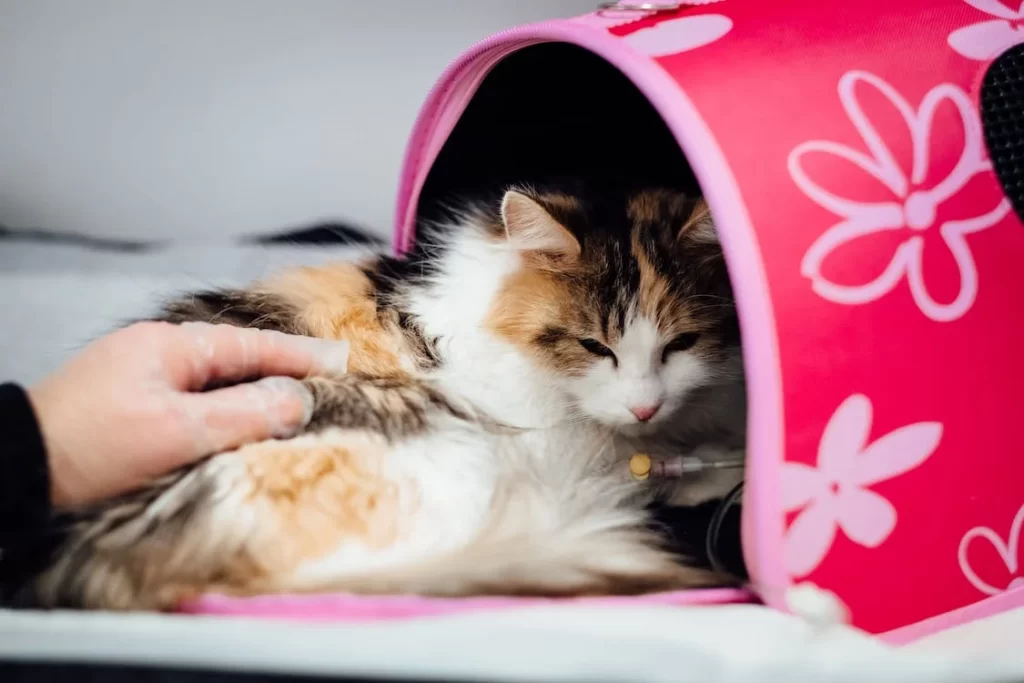Last updated on February 17th, 2023 at 02:01 pm

Is your cat having difficulty peeing? Or maybe they can’t pee at all? If that’s the case, then there may be a high chance that your cat has Struvite Crystals. Cats and dogs usually have crystals forming in their urinary tract, and sometimes, it is not a case for concern. But, if your cat is starting to feel pain while peeing, like a urinary tract infection, you should consult a vet to help your cat. But is there any other way to help your cat dissolve struvite crystals?
Don’t worry! The good news is you can dissolve struvite crystals in cats. This article will discuss Struvite crystal and how you can help your cat get through it. We will include symptoms to look out for and possible medical treatments and home remedies to soothe your cat. Of course, help from your vet will make things easier as they will give you pointers on what you need to do, especially if your cat is experiencing severe pain and illness from struvite crystals.
What Are Struvite Crystals?
Struvite crystals are a common problem in cats and the most effective way of dissolving them is with medical intervention. In many cases, your veterinarian will prescribe an acidifying diet and/or medication to dissolve the crystals. Struvite crystals in cats are mineral deposits that form in the bladder or urinary tract of a cat. These crystals can cause a great deal of pain and discomfort for the cat if left untreated. they are made up of magnesium, ammonium and phosphate, and this combination can lead to the formation of stones or other blockages in the urinary tract.
Don’t worry; it sounds terrifying, but all of these can be prevented. Struvite crystals start to build like solid stones when your cat resists drinking lots of water. Cats aren’t the type of animals who loves to drink. This is because they mainly get their water from their food. This is also why most cat foods you see in the market are wet food. Since cats are not really fond of water, the solution is to feed them moist foods. To prevent all of these from happening in the first place, try to give your Cat a lot of fluids. Now that we know what these crystals do and how they form, let’s look at the symptoms and diagnosis of struvite crystals in cats.
Symptoms
As you may now know, struvite crystal is a challenging experience for your cat. Even if it is considered normal, some symptoms can indicate a more profound condition that can be fatal to your Cat. Here are some of the signs and symptoms to look out for.
- A cat with crystals or stone build-up will start to urinate outside the litter box. This is because the litter sometimes causes pain and irritation to your feline friend when urinating.
- Frequent urination: This is the most common symptom and cats that have struvite crystals in their urinary tract may strain to urinate and may vocalize when attempting to urinate. They may also urinate more frequently, and their urine may be dark and have an unpleasant odor.
- Cats may have difficulty urinating, which can cause them to lick their genitals more frequently than usual.
- A cat with stones will have bloody urine. This is because crystals/stones will infect the bladder wall, causing it to bleed.
- Stones can also damage the kidney of your feline companion. When that happens, you’ll notice that your Cat will start to feel lethargic.
- Loss of Appetite.
If you notice a few of these symptoms, contact your vet immediately. Struvite crystals can easily be treated, but if it escalates to the point where the kidney is also damaged, the chances of survival will be lower.
What Causes Struvite Crystals In Cats?
Urinary tract infections are the most common cause of struvite crystals in cats. UTIs are caused by bacteria that can enter the cat’s system via the urinary tract. Bacterial infections such as E. coli, Mycoplasma, and Staphylococcus are common culprits. These infections can cause irritation and inflammation of the bladder and urethra, leading to the formation of struvite crystals. The bacteria can cause an imbalance in the pH of the cat’s urine, which can then lead to the formation of struvite crystals.
Another cause of struvite crystals in cats is an improper diet. Cats that are fed a diet that is too high in carbohydrates and low in protein can be more prone to forming these crystals. High-carb diets can cause an alkaline environment in the cat’s bladder, which can cause the formation of struvite crystals. Stress can also be a contributing factor to struvite crystal formation. Cats that are under a great deal of stress may be more prone to developing struvite crystals. Additionally, struvite crystals may form due to genetic predisposition. Certain breeds, such as Persians, are more prone to forming struvite crystals than other breeds.
It’s also important to note that dietary supplements and the main diet of your Cat can affect their urine. Like in people, when cats consume too much magnesium or phosphorus, commonly found in vitamins, there’s a big chance that cats will develop urinary tract infections. Salty diets and cat foods can also boost the development of these stones. It’s better to invest in much more expensive cat food that let your Cat suffer pain from struvite crystals. To ensure that your Cat’s food is good for them, consult your vet.
How Do Vets Diagnose Struvite Crystals In Cats?
Like any other health condition, your veterinarian will run a series of tests to pinpoint the root cause of pain or inflammation. These include a lot of bloodwork and analysis. To explain it more, here are some of the expected lists of diagnosis you should expect.
- History or Background Check. Like regular human hospitals, your vet will run a history check first to know how the condition develops. This includes checking their past behavior, the food they eat, current environment, and regular routine. Don’t worry, it will look like a typical interview, but it will surely help your vet to confirm what’s going on.
- Physical Examination. After carefully analyzing your Cat’s behavior and history, your vet will conduct a physical examination. This sometimes includes checking their heart rate, their physique, and how they function.
- Urinalysis and CBC. This might be one of the most important tests as this will also determine what type of stone your Cat has. CBC will also detect whether the stones affect other organs, ensuring that the only problem is the stones.
- Ultrasounds. It is one of the most effective approaches to diagnosing bladder stones. Ultrasounds and X-rays are usually done, so your vet will know how big the crystal is and where is the exact location.
- Urine Culture. Aside from Urinalysis, a Urine Culture test is also essential to know what type of bacteria causes the infection. This will help them determine the type of antibiotic your Cat will need.
These tests will be a challenging experience for you and your Cat. There will be many injections and blood draws that can sometimes weaken your Cat. However, it would be best if you always remember that these are necessary to ensure that your Cat has the proper medication and treatment. As mentioned above, some crystals can be passed using medications, while some require surgery. These tests will determine it.
How To Dissolve Struvite Crystals In Cats?
After a series of blood works, your vet will recommend a few things to dissolve and remove struvite crystals from your cats. Here are a few methods that your vet will recommend for your cat.
- Dietary Changes. Along with medications, your vet can recommend a new dietary and nutritional plan for your cats. They’ll recommend that you feed your cat moist cat foods that are high in acid to balance the pH level in your cat’s urine. These are special diets that should be followed. After that, vets will check if it is effective by using radiographs to see if it dissolves the stones.
- Cystoscopy. This is a procedure that can only be used on female cats. This includes a long camera that will be inserted inside the bladder of your cat. They will manually remove the stones using a stone basket in this procedure. If the stones are too large, they will use a laser to break them down to pieces before removing them.
- Surgical Procedure. Surgery is probably one of the safest and quickest ways to remove crystals and stones. It’s a routine procedure; your vet probably does it many times before doing it with your Cat. Don’t worry, as this procedure is very safe, and your Cat will return to good health in no time.
Home remedies can work, but sometimes, the condition is too severe that vets have to provide the option of surgically removing it. Don’t worry, as we will also discuss a few home remedies you can do for your Cat. These procedures should be followed first before you try anything for your Cat.
Natural Remedies To Dissolve Struvite Crystal In Cats
Not a lot of fur parents will love the idea of putting their Cat under a knife or doing harsh procedures that will cost a lot of money. That’s why there are a few home remedies you can do. Of course, as we always say, it’s important to note that these home remedies should be used to continue medication, and we encourage cat owners to consult a vet.
Here are the following remedies that can be good for prevention and recovery.
- Diet Change: One of the best remedies for struvite crystals in cats is to change their diet. Cats require specific amounts of vitamins and minerals in their diet, and struvite crystals can form if these levels are too high. Feeding your cat a food that is low in magnesium, phosphorus, and protein can help keep struvite crystals from forming. Special diets are available from your veterinarian that are designed to reduce the formation of struvite crystals.
- Increase Water Intake: Increasing your cat’s water intake can help reduce the formation of struvite crystals in cats. Cats naturally don’t drink a lot of water, so it is important to make sure they are getting enough. Providing multiple water sources throughout the house can help encourage them to drink more. Adding a little bit of tuna juice or broth to the water can also help entice them to drink more.
- Urinary Acidifiers: Urinary acidifiers can help reduce the formation of struvite crystals in cats. These products can be added to their food or water and will help reduce the pH of their urine, making it harder for struvite crystals to form.
- Use Marshmallow Root. Since it calms and lubricates the mucosal membranes, it makes passing the stones easier. It reduces irritation in the urinary system, making it an effective home treatment for struvite crystal removal.
- Cranberries. In the same way that people utilize cranberries to treat urinary tract infections (UTIs), so can cats. Cranberries’ acidic characteristics can alter the pH of your Cat’s urine, which can be beneficial for treating and preventing urinary tract infections.
- Reduce Environmental Stress. A happy cat means a healthy cat. Always ensure your Cat is living in a stress-free environment where it can quickly recover. Also, reducing stress can make your Cat healthier, the same with people.
Even if your Cat is not sick, you should still make sure that you have them checked. Some illnesses won’t easily be detected, and regular visits can help your Cat if it is the case. A regular trip to the vet can also make a big difference.
Conclusion
Struvite crystals are a normal part of your Cat’s life, but it becomes problematic when it builds a stone that causes urethral blockage. Their food, environment, and habits can be significant factors in it. The good thing is that you can prevent it by following a few things and having regular visits to the vet.
We hope this article gave you the answers about how to dissolve Struvite Crystals in cats. So, if you want a cat free from Struvite pain, ensure that your Cat has enough water to drink. It’s the simplest yet most effective thing you can do for your cat. Remember, prevention is better than cure.


